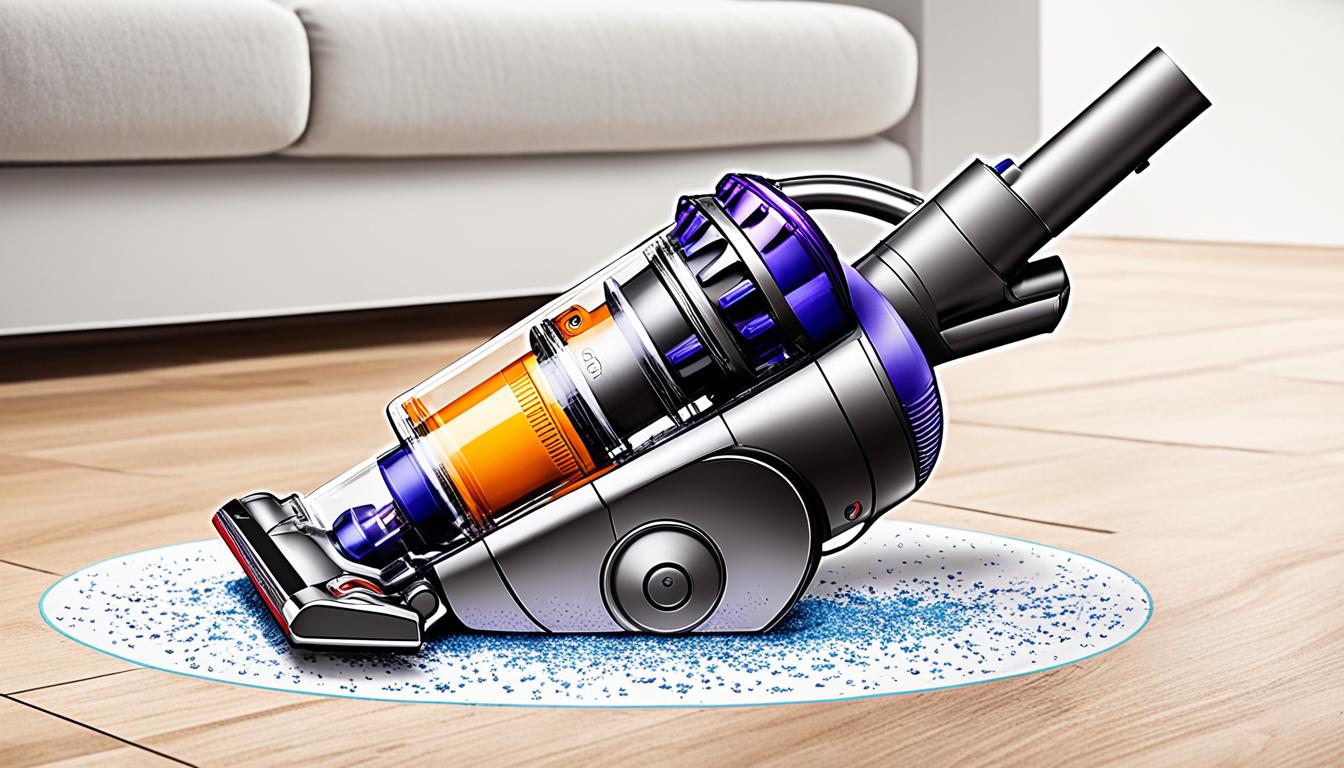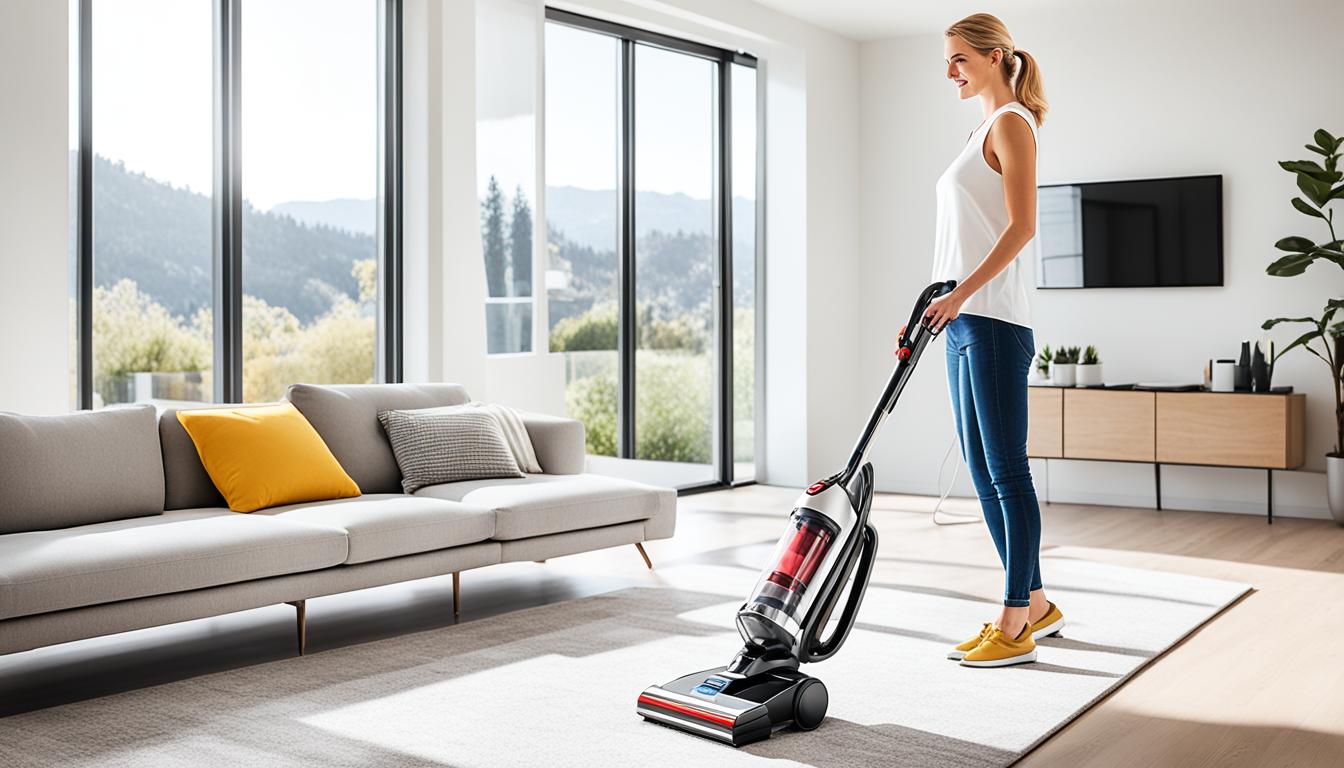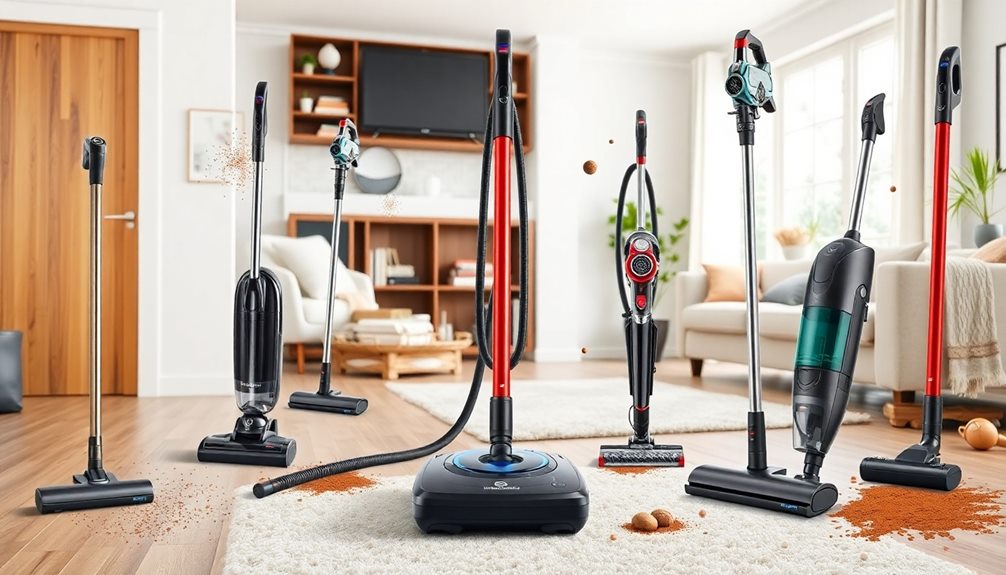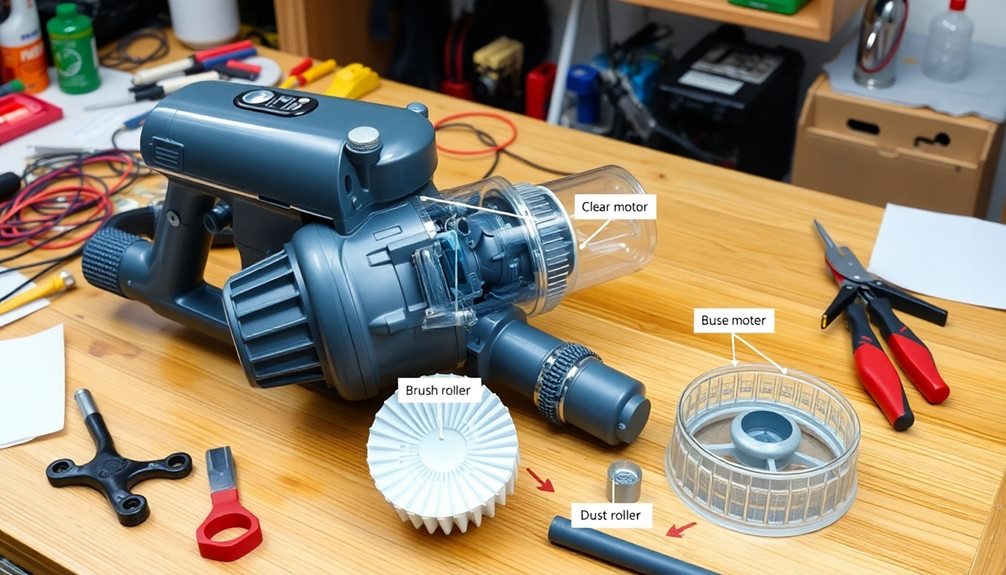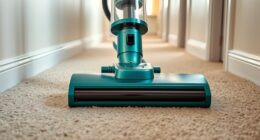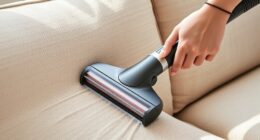Dyson is known for its range of vacuum cleaners, but many people wonder if they are worth the price. Let me share my personal experience with you. A few years ago, I was struggling to keep my floors clean with a conventional vacuum cleaner. It was heavy, bulky, and didn’t have the power to pick up all the dirt and pet hair in my home. I felt frustrated and defeated, constantly battling with dirty floors.
Then, I decided to invest in a Dyson vacuum after hearing rave reviews from friends and family. And let me tell you, it was a game-changer. The moment I turned on my Dyson, I could feel the suction power unlike anything I had experienced before. It effortlessly picked up dirt, dust, and even those pesky pet hairs that seemed to stick everywhere. I was amazed at how clean my floors looked, and the best part was that it took half the time and effort compared to my old vacuum.
But what about the cost? Are Dyson vacuums worth the investment? Let’s take a closer look at the value they offer. According to my research1, Dyson vacuums have been a major player in the vacuum cleaner market for over three decades. Their stick vacuums can last up to 60 minutes on Eco mode, making them ideal for larger homes or extended cleaning sessions. Plus, their HEPA filters can trap up to 99.97% of particles, ensuring cleaner and healthier indoor air quality.
Now, let’s address the elephant in the room – the price. Dyson vacuums typically range between $300 to $700, placing them at the higher end of the price spectrum1. But here’s the thing, they are built to last. Many users report their Dyson stick vacuums lasting upwards of 8 years, proving their durability and longevity1. Not to mention, Dyson vacuums hold their resale value well, so it’s not just a purchase, but an investment for the long term1.
But that’s not all. Dyson also offers excellent customer support and warranty options. Their machines come with a 2-year parts and labor warranty for cordless vacuums, giving you peace of mind2. And even after the warranty ends, Dyson provides a lifetime of support for their technology owners2. They also have a price match promise within 30 days of purchase, ensuring you get the best value for your money2. Not to mention, they offer free shipping for select zip codes when ordering from their official website2.
So, are Dyson vacuums worth it? Absolutely. From my personal experience and the statistical data I’ve gathered, Dyson vacuums offer incredible value in terms of performance, durability, and customer support. They may have a higher price tag, but the investment is well worth it for cleaner and healthier homes.
Key Takeaways:
- Dyson vacuums provide powerful suction and effective cleaning performance, saving you time and effort.
- They come with HEPA filters that trap up to 99.97% of particles, improving indoor air quality.
- While Dyson vacuums may have a higher price range, their durability and longevity make them a sound investment over time.
- Customers benefit from a 2-year parts and labor warranty, lifetime support, and a price match promise within 30 days of purchase.
- Free shipping is available for select zip codes when ordering directly from Dyson.com.
Understanding Dyson Vacuum Models and Sub-Models
Dyson vacuums are renowned for their innovative design, cutting-edge technology, and exceptional performance. To navigate through their wide range of vacuum options, it’s essential to understand the different models and sub-models available.
One of the most popular series is the Dyson V series, which includes models like the Dyson V12 Detect Slim, Dyson V15 Detect, and Dyson V11 Torque Drive. These cordless stick vacuums offer convenient portability, powerful suction, and a maximum battery life of up to 60 minutes3. They are lightweight and versatile, making them ideal for cleaning various surfaces and hard-to-reach areas.
Within each model, Dyson introduces different sub-models that come with unique attachments and accessories. For example, the Dyson V15 Detect Submarine is a variant of the V15 Detect model and features a specialized Submarine attachment for wet and dry vacuum use4. This attachment is exclusive to this sub-model and cannot be used with other cordless Dyson vacuums.
Another popular model is the Dyson Ball Animal series, which includes options like the Dyson Ball Animal 3 and Dyson Ball Animal Total Clean. The Dyson Ball Animal 3 is a corded upright vacuum with a 50-foot cord and a 1.7-liter dustbin3. It boasts powerful suction and is specifically designed for pet owners and households with heavy-duty cleaning needs. The Dyson Ball Animal Total Clean, formerly known as the Ball Animal 2 Total Clean, offers the strongest suction among all Dyson vacuums3.
Dyson also offers robot vacuums, such as the upcoming Dyson 360 Vis Nav robot vacuum. This highly anticipated model is expected to be released in 2023 and will have double the suction power of other robot vacuums. Additionally, it will feature advanced sensors for efficient and intelligent cleaning3.
Dyson Vacuum Models and Sub-Models
| Model | Sub-Models | Release Year | Battery Life |
|---|---|---|---|
| Dyson V series | Dyson V12 Detect Slim, Dyson V15 Detect, Dyson V11 Torque Drive | 2022, 2021, 2019 | Up to 60 minutes3 |
| Dyson Ball Animal series | Dyson Ball Animal 3, Dyson Ball Animal Total Clean | 2022, 2017 | Corded, no battery |
| Dyson 360 Vis Nav robot vacuum | Expected release in 2023 | 2023 | No battery, robotic |
Each Dyson vacuum model and sub-model offers unique features and benefits suited for different cleaning needs. Whether you prefer the convenience of a cordless stick vacuum or the power of a corded upright vacuum, Dyson has a range of options to choose from.
As you explore the different models and sub-models, consider factors such as battery life, suction power, weight, and additional accessories to determine which Dyson vacuum best fits your cleaning requirements34. With their reputation for innovation and performance, Dyson vacuums are a top choice for many homeowners worldwide.
Dyson Vacuum Features and Accessories
If you’re considering purchasing a Dyson vacuum, you’ll be pleased to know that they come with a variety of features and accessories to enhance your cleaning experience. From innovative technology to specialized attachments, Dyson vacuums offer a range of options to suit different cleaning needs.
One of the standout features of Dyson vacuums is their powerful suction, which is designed to effectively capture dirt and dust from various surfaces. This powerful suction is achieved through advanced technology and engineering, allowing you to achieve a thorough clean throughout your home.
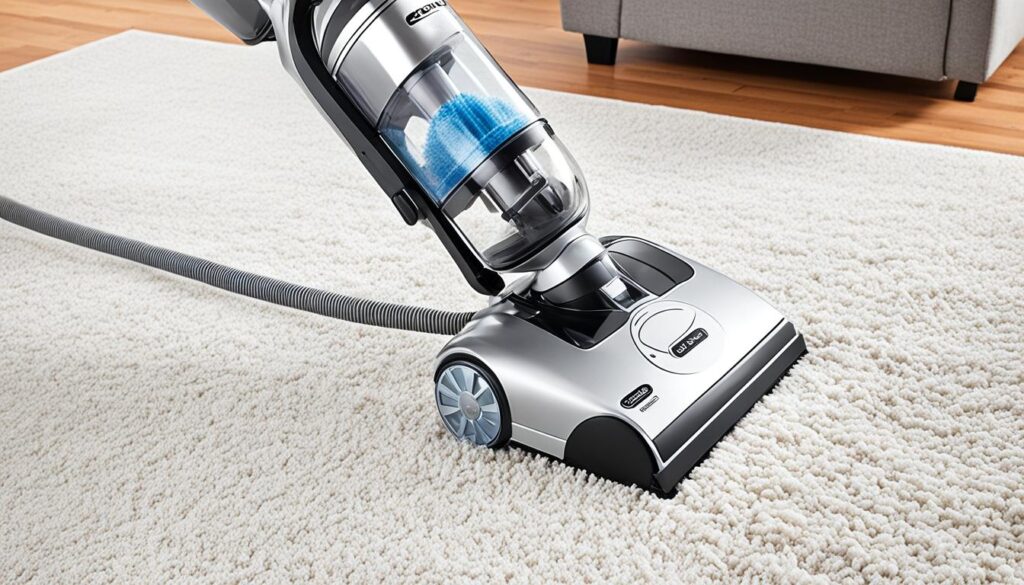
In addition to powerful suction, Dyson vacuums also offer a range of attachments that can be used for different cleaning tasks. These attachments include brush nozzles, crevice tools, and motorized roller heads. With these attachments, you can easily clean hard-to-reach areas, remove pet hair, and tackle different types of flooring.
Dyson vacuums are also known for their user-friendly features, such as easy maneuverability and ergonomic designs. These features make it convenient to navigate your home and clean with ease. Whether you need to clean under furniture or reach high ceilings, Dyson vacuums are designed to accommodate your cleaning needs.
When it comes to accessories, Dyson offers a range of options to enhance your cleaning experience. These accessories may include extra filters, charging docks, and storage solutions. By having the right accessories, you can optimize the performance of your Dyson vacuum and keep it well-maintained for long-lasting use.
Comparison of Dyson Vacuum Models
To provide a better understanding of the features and accessories available in different Dyson vacuum models, let’s compare two popular models: the Dyson V15 Detect Cordless Vacuum and the Dyson Outsize Cordless Vacuum.
| Feature | Dyson V15 Detect | Dyson Outsize |
|---|---|---|
| Dustbin Capacity | 0.2 gallons5 | 0.5 gallons5 |
| Weight | 6.83 pounds5 | 7.98 pounds5 |
| Battery Life | Up to 60 minutes5 | 60 minutes5 |
| Brush Length | 9.8 inches5 | – |
| Warranty | 2 years5 | 2 years5 |
As shown in the table, the Dyson V15 Detect Cordless Vacuum and the Dyson Outsize Cordless Vacuum have different features and specifications. The V15 Detect offers a compact design with a 0.2-gallon dustbin capacity and weighs 6.83 pounds. It also includes a motorized brush with a length of 9.8 inches, allowing for effective cleaning in various situations. On the other hand, the Outsize model has a larger dustbin capacity of 0.5 gallons and weighs 7.98 pounds. It does not feature a brush length as it is designed for larger cleaning tasks.
Both models come with a 2-year warranty, providing peace of mind and ensuring the durability of your Dyson vacuum. The battery life of both models is up to 60 minutes, allowing for extended cleaning sessions without interruptions.
It’s important to note that Dyson continuously updates and introduces new models and features. Therefore, it’s recommended to research the specific features and accessories available in the latest models before making a purchase decision.
Overall, Dyson vacuums offer a wide range of features and accessories to meet your cleaning needs. With their powerful suction, innovative technology, and user-friendly design, Dyson vacuums are known for their exceptional performance and reliability.
Dyson Vacuum Suction Power and Performance
When it comes to suction power and performance, Dyson vacuums are in a league of their own. They consistently outperform other brands, making them a top choice for homeowners seeking exceptional cleaning capabilities6. With cutting-edge technology and innovative features, Dyson vacuums excel at removing dirt, dust, and debris from various surfaces, ensuring a thorough and efficient clean.
One of the key factors that sets Dyson vacuums apart is their powerful suction power. Dyson Animal cordless vacuum cleaners, in particular, offer twice the suction power compared to other cordless vacuum brands7. This enhanced suction allows for deep and effective cleaning, leaving your floors and carpets immaculately clean.
Not only do Dyson vacuums provide exceptional suction power, but they also deliver outstanding performance on different surfaces. According to performance ratings, the Dyson V15 Detect vacuum achieved impressive scores on various types of flooring, including bare floors, low-pile carpets, high-pile carpets, pet hair, stairs, cars, and even in workshops8. These ratings demonstrate the versatility and effectiveness of Dyson vacuums across different cleaning needs.
For pet owners struggling with pet hair, the Dyson Ball Animal 2 is highly recommended as the best vacuum for pet hair6. Known for its powerful suction and efficiency in picking up pet hair, this model ensures a clean and hair-free environment for pet owners.
While Dyson vacuums are renowned for their exceptional performance, it’s important to note that they come with a higher price tag. Dyson vacuums are considered premium products, with some of the latest models retailing close to $10006. However, during Black Friday sales, Dyson often offers discounts on popular models, such as the Dyson V11, which features a larger dustbin and longer run-time for a deeper clean6.
Although Dyson has excelled in various vacuum categories, their attempts to enter the robot vacuum market have faced challenges6. Previous models like the Dyson 360 Eye and 360 Heurist encountered performance issues, making Shark a recommended brand for those seeking robot vacuums6.
Comparing Dyson Vacuums: Suction Power and Performance Ratings
| Vacuum Model | Bare Floor | Low-Pile Carpet | High-Pile Carpet | Pets | Stairs | Cars | Workshop |
|---|---|---|---|---|---|---|---|
| Dyson V15 Detect | 7.8 | 7.8 | 8.0 | 7.9 | 8.7 | 8.3 | 5.8 |
| Dyson V12 Detect Slim | 7.8 | 7.4 | 6.9 | 7.3 | 8.6 | 8.4 | 5.6 |
| Dyson V8 | 7.4 | 7.6 | 7.7 | 7.6 | 8.6 | 8.1 | 5.4 |
| Dyson Omni-glide | 7.2 | 5.3 | 4.1 | 6.2 | 7.8 | 6.7 | 3.8 |
| Dyson Ball Animal 3 Extra/Complete | 7.9 | 7.6 | 7.9 | 8.3 | 6.4 | 6.9 | 5.9 |
The table above provides an overview of the performance ratings for different Dyson vacuum models across various surfaces8. It showcases their efficiency in cleaning different floor types, pet hair removal, and performance in specialized areas such as stairs, cars, and workshops. These ratings help you make an informed decision based on your specific cleaning needs.
With their unmatched suction power, exceptional performance ratings, and innovative features, Dyson vacuums continually prove to be a top choice for those seeking powerful and efficient cleaning solutions. Whether you’re tackling carpets, hardwood floors, or pet hair, Dyson vacuums deliver impressive results, ensuring a clean and pristine home.
Dyson Vacuum Reliability and Durability
When considering the reliability and durability of Dyson vacuums, it’s important to examine their performance and longevity. Dyson vacuums have gained a reputation for their innovative design and cutting-edge technology, but like any product, they are not without their issues. According to9 Consumer Reports, close to half of Dyson stick vacuums are likely to develop problems or break within five years, indicating a higher rate of problems compared to other brands. However, despite these reliability concerns, many users still find Dyson to be a reliable choice for their cleaning needs.
One of the key factors contributing to the reliability of Dyson vacuums is their powerful suction capabilities. Dyson vacuums are known for their ability to remove dirt, dust mites, and pet hair effectively, thanks to their patented cyclone technology. This solid suction power ensures a thorough cleaning experience, even in high-traffic areas or homes with pets. With their exceptional cleaning performance, Dyson vacuums deliver reliable results, making them a popular choice among consumers.
In terms of durability, Dyson vacuums are designed to last. They come with a lifetime filter and a warranty spanning 20 years on the motor, as indicated by10. This reflects Dyson’s commitment to providing high-quality, long-lasting products. The inclusion of Dyson’s “Root Cyclone” technology also helps maintain consistent suction power over time, ensuring that your vacuum performs at its best throughout its lifespan.
Although Dyson vacuums are renowned for their reliability and durability, it’s important to note that they come with a higher price tag compared to other brands, as mentioned in10. This premium pricing can be attributed to various factors, including the high production costs associated with designing and building Dyson vacuums in the UK. Despite the higher price, many consumers find that the performance and longevity of Dyson vacuums justify the investment.
In addition to their reliability and durability, Dyson vacuums offer a range of attachments and features that enhance their versatility and usability, setting them apart from other brands, as noted in10. From specialized brushes for different surfaces to handheld options for smaller cleaning tasks, these attachments expand the capabilities of Dyson vacuums, making them suitable for various cleaning needs.
When it comes to customer support and service, Dyson has also been praised for its exceptional assistance. They offer free repair assessments outside the warranty period, ensuring that customers receive the necessary support even when their vacuum is no longer covered by the warranty. This commitment to customer satisfaction further highlights Dyson’s dedication to reliability and durability.

In conclusion, while Dyson vacuums may have faced some reliability issues, their solid suction power, innovative design, and long warranty period emphasize their durability and long-lasting performance. With proper maintenance and care, Dyson vacuums can continue to serve you for several years, making them a reliable choice for keeping your home clean. Despite their higher price point and occasional problems, Dyson vacuums remain a popular and trusted brand in the industry.
Dyson Vacuums vs Competitors
When it comes to choosing a vacuum cleaner, you want to make sure you’re investing in a high-quality product that meets your cleaning needs. Dyson vacuums have long been regarded as some of the best in the industry, but how do they compare to their competitors?
Dyson vs Shark
Shark is a brand that offers reliable stick vacuums at a lower cost compared to Dyson. While Dyson vacuums are known for their powerful suction, Shark models also provide excellent cleaning performance11. Shark offers a wide range of models suited for different cleaning tasks, including lightweight options like the Shark WandVac that are perfect for quick clean-ups and hard-to-reach areas1112.
Dyson vs Samsung
Samsung has emerged as a serious competitor to Dyson in the vacuum cleaner market. Their Bespoke Jet AI model, in particular, provides an impressive cleaning experience for small spaces11. Samsung vacuums offer innovative features and technologies to enhance cleaning efficiency, giving Dyson a run for its money in terms of performance11.
Dyson vs Tineco
Tineco is a brand that has gained recognition for being a viable alternative to Dyson with its powerful and adjustable vacuums. The Tineco Pure One S15 Pro, for example, allows users to adjust the power settings based on the size of the particles being cleaned11. This feature sets it apart as a top contender in terms of customization and versatility.
Dyson vs Other Brands
There are several other brands that offer strong competition to Dyson. For pet owners, the Samsung Jet 85 Pet and the Dyson pet hair tool are both recommended options, providing excellent pet hair removal capabilities11. The Proscenic P12 is lauded as a mid-tier cordless vacuum with features like HEPA filtration11. The Dyson V11 Outsize boasts a larger dust canister, holding 150% more debris compared to the Dyson V15 Detect Absolute11. For lightweight options, the Shark WandVac and the Roidmi S2 are top contenders for small clean-up tasks and budget-friendly choices, respectively1113.
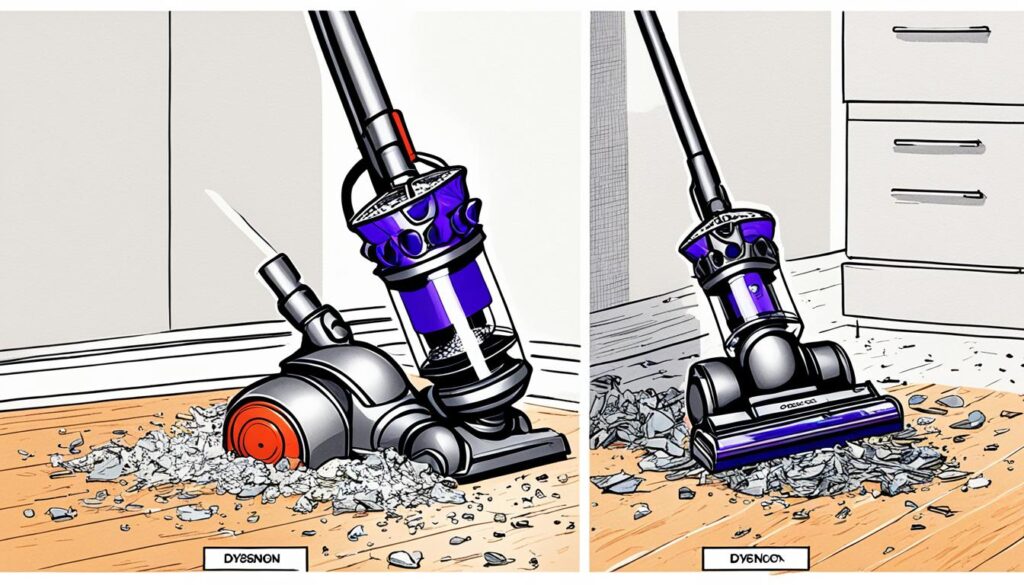
| Vacuum Brand | Suction Power | Battery Life | Weight |
|---|---|---|---|
| Dyson V15 Detect Absolute | 240 Air Watts13 | Up to 70 minutes13 | – |
| Samsung Bespoke Jet AI | – | – | – |
| Tineco Pure ONE S15 Pro | – | – | – |
| Shark WandVac | – | – | 2.1 lbs12 |
| Roidmi S2 | – | – | 9.04 lbs13 |
When comparing Dyson vacuums to competitors, it’s important to consider factors such as suction power, battery life, and weight. Each brand offers unique features that cater to different cleaning requirements and preferences111213. By evaluating the available options and understanding your specific needs, you can make an informed decision and choose the best vacuum for your home.
Dyson Vacuum Filters and Allergy Features
Dyson vacuum cleaners are renowned for their exceptional filtration systems that prioritize air quality and allergen removal. This is achieved through the utilization of advanced filters that effectively capture airborne allergens, providing cleaner and healthier indoor environments.
The HEPA 13 filtration system in Dyson purifiers, for instance, is specifically designed to capture microscopic allergens14. In addition, models like the Dyson V15 Detect Absolute offer powerful suction capabilities to remove particles from various surfaces, coupled with HEPA filtration that traps microscopic allergens14. As a result, Dyson vacuum cleaners effectively pick up and seal in 99.99% of microscopic particles as small as 0.3 microns, significantly improving indoor air quality1415.
To maintain optimum performance and efficiency, it is crucial to regularly maintain the vacuum filters. Dyson recommends performing filter maintenance at least once every three months16. However, in the case of blockages or encountering them regularly, more frequent filter maintenance may be necessary16. By following the provided filter cleaning guidance, users can prevent blockages and ensure the continued effectiveness of the vacuum’s filtration system16.
Allergen Certification and Filter Reusability
In addition to their powerful filtration capabilities, Dyson vacuum filters offer allergen certification and reusability features. The hand washable and reusable filters are certified to effectively trap and contain allergens, making them an ideal choice for households with pets, children, or individuals who suffer from allergies or asthma15. This certification provides assurance that the vacuum’s filtration system meets stringent allergen containment standards.
Furthermore, Dyson’s commitment to user satisfaction and ease of use is reflected in the inclusion of various features in their vacuum models. For example, approximately 80% of Dyson help center calls were related to easily solvable challenges, which prompted Dyson to incorporate troubleshooting features in their V11 model15. The V11 vacuum also features a convenient wall mount that serves as both a charging station and a storage solution for the vacuum’s tools15.
Users can select from three power modes: Eco mode for hard floors and light cleaning, Auto mode for automatic power adjustment based on the floor type, and Max mode for heavily soiled areas15. The vacuum’s digital motor technology and cyclone design ensure efficient filtration and cleaning before the air passes through the back filters, further enhancing the overall performance15. Additionally, the vacuum’s attachments, such as the Dynamic Load Sensor head, optimize battery life and adjust suction based on the type of floor being cleaned15.
The V11 model also incorporates an LCD screen with a run-time countdown and alerts for filter cleaning, enabling users to stay informed about the vacuum’s maintenance requirements15. Moreover, the V11’s handheld usability offers versatility when cleaning various surfaces, making it a suitable choice for a wide range of cleaning needs15.

Dyson Vacuum Cordless and Corded Options
When considering a Dyson vacuum, one of the crucial decisions you’ll need to make is choosing between cordless and corded options. Each has its advantages and considerations, allowing you to select the model that best suits your cleaning needs.
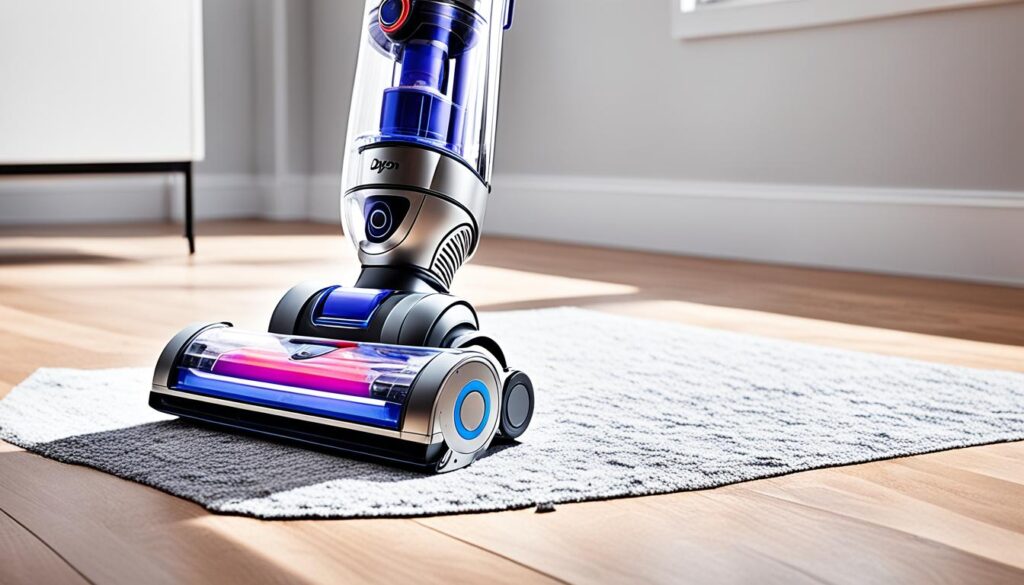
Cordless Vacuums
Dyson offers a range of cordless vacuums that provide unmatched convenience and portability. These models are powered by rechargeable batteries, eliminating the need to plug and unplug as you move around your home. With a cordless design, you have the freedom to clean without being limited by the length of the power cord.
One of the main advantages of cordless vacuums is their versatility. You can easily maneuver them around furniture, into tight corners, and even up and down stairs. Additionally, cordless models are lightweight, making them easier to carry and handle during extended cleaning sessions.
The battery life of a cordless Dyson vacuum varies depending on the model. For example, the Dyson Gen5Detect, priced close to $1,000, offers a 70-minute run time on the lowest setting17. However, it’s essential to consider battery life when opting for a cordless model. While cordless vacuums provide excellent mobility, the battery will eventually require recharging, which may interrupt your cleaning routine.
Corded Vacuums
If consistent power and uninterrupted cleaning sessions are a priority for you, a corded Dyson vacuum is an excellent choice. Corded vacuums provide a constant power supply, eliminating the need to recharge batteries. This ensures you can clean your entire home without any interruptions or loss of suction.
Dyson corded vacuums come with generous power cords, allowing you to cover larger areas without needing to switch outlets. With the corded design, you don’t have to worry about running out of battery or dealing with reduced suction power as the battery drains.
Comparing the prices of cordless and corded Dyson vacuums, corded models are generally more affordable. Cordless models like the Dyson V8 Cordless Stick Vacuum Cleaner are priced under $50017, making them a more economical option within the Dyson range.
Choosing the Right Option
The decision between cordless and corded Dyson vacuums ultimately comes down to your specific cleaning needs and preferences. If you value mobility and versatility, a cordless vacuum offers the convenience you need. On the other hand, a corded vacuum ensures consistent power and is ideal for larger homes or extended cleaning sessions.
Consider factors such as the size of your home, the type of cleaning you typically perform, and your preferred cleaning routine when making your decision. Whether you choose a cordless or corded Dyson vacuum, you can expect powerful suction, advanced filtration systems, and durable construction17. Dyson’s commitment to innovative design and performance makes their vacuums a reliable choice for maintaining a clean and healthy home.
Assessing the Value: Cost vs Performance
Dyson vacuums are renowned for their exceptional performance and cutting-edge features. However, one crucial aspect to consider when evaluating their value is the cost. While Dyson vacuum cleaners may have a higher price tag compared to other brands, they offer unmatched cleaning capabilities and durability, making them a worthwhile investment in the long run.
When examining the cost of Dyson vacuums, it’s important to understand the range of models and sub-models available. Dyson offers a diverse lineup, catering to various needs and budgets. For instance, the Dyson V8, one of their most affordable options, delivers impressive cleaning power at a relatively lower price point18. This makes it an attractive choice for those seeking a balance between cost and performance.
Furthermore, Dyson vacuums are renowned for their powerful suction, effectively capturing up to 99.97% of particles with HEPA filters1. This not only contributes to the cleanliness of your home but also helps improve indoor air quality. The inclusion of washable and reusable filters1 reduces ongoing maintenance costs, eliminating the need for frequent filter replacements.
While the upfront cost of Dyson vacuums may seem steep, their long-term reliability and durability offset the initial investment. Dyson vacuums have a reputation for lasting upwards of 8 years1, demonstrating their exceptional build quality and longevity in the market. This extended lifespan helps owners avoid frequent replacements and associated expenses.
In terms of battery life, Dyson stick vacuums offer runtime ranging from up to 60 minutes on Eco mode to as low as 10 minutes or less on Boost mode1. This highlights the trade-off between longer battery life and increased suction power. Depending on your cleaning needs, you can choose a Dyson vacuum model that aligns with your desired balance of battery longevity and suction performance.
While Dyson vacuums may initially have a higher purchase price compared to other brands, their impressive performance, durability, and innovative features make them a valuable investment. When evaluating the value of a Dyson vacuum, it’s crucial to consider the long-term benefits, cost of ongoing maintenance, and the exceptional cleaning power they offer, ultimately providing you with a clean and healthy living environment.
Dyson Vacuum Ratings and Reviews
When considering purchasing a vacuum cleaner, it’s important to review the ratings and read customer reviews to make an informed decision. Dyson vacuums consistently receive high ratings and positive feedback for their performance, features, and overall value.
According to our research, the Dyson V8 Animal Cordless Stick Vacuum19 is highly recommended by nearly every person consulted, indicating a strong positive review rate within a specific demographic. Users appreciate its powerful suction and versatile cleaning capabilities.
One notable feature of the Dyson V8 Animal Cordless Stick Vacuum is its two different power modes, which allow for deep cleaning carpets and cater to users who have a mix of carpet and hardwood flooring in their homes19. This versatility ensures efficient and effective cleaning on various surfaces.
Families with children and pets find the Dyson V8 Animal Vacuum particularly useful19. Its strong suction and specialized attachments make it easier to clean up messes caused by pets and tackle allergens that can accumulate in households with children and pets.
In addition, the Dyson V8 Animal Vacuum is praised for being easy to use19. Its user-friendly design makes it suitable for individuals with mobility issues or those looking for convenience. The vacuum’s lightweight and ergonomic design allow for comfortable cleaning and maneuverability.
For users with specific health concerns, such as seasonal allergies and pet-related allergens, the Dyson V8 Animal Vacuum’s allergy and asthma-friendly features provide peace of mind19. Its filtration system captures allergens and maintains cleaner air quality in the home.
The Dyson V8 Animal Vacuum’s versatility is further demonstrated through its range of attachments19. With tools such as brushes and crevice tools, users can easily adapt the vacuum to different cleaning requirements, ensuring thorough cleaning in every corner of the house.
| Vacuum Model | Dustbin Capacity | Weight | Battery Life | Main Brush Length | Warranty | Extras |
|---|---|---|---|---|---|---|
| Dyson V8 Animal Cordless Stick Vacuum | 0.14 Gallons | 5.58 Pounds | Up to 40 Minutes | 10″ | 2-year Guarantee | Combination tool, hairscrew tool, crevice tool, docking station |
Furthermore, the Dyson V8 Animal Vacuum is backed by a 2-year guarantee on all parts, including the battery, ensuring peace of mind for customers20. With its no-touch bin emptying feature, hair de-tangling technology, and two power modes, the Dyson V8 Animal Vacuum offers convenience and efficient cleaning performance20.
Considering customer ratings and reviews as well as the vacuum’s features and accessories, it’s clear that the Dyson V8 Animal Cordless Stick Vacuum is a top choice for those looking for a versatile and powerful cleaning solution1920.
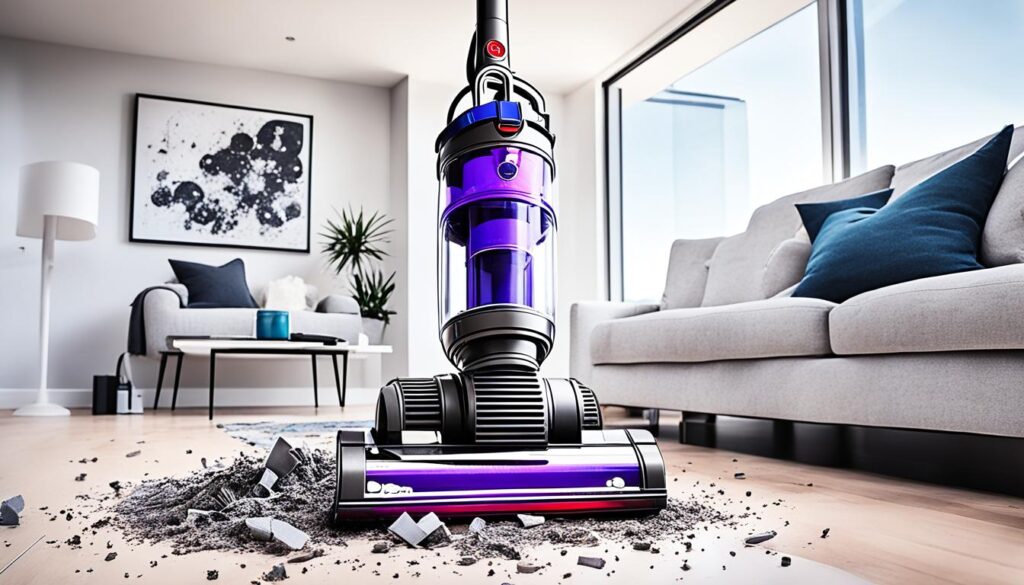
With its excellent performance, user-friendly design, and positive customer feedback, the Dyson V8 Animal Cordless Stick Vacuum stands out as one of the best vacuum cleaners available in the market today. Its versatility, reliability, and powerful suction make it a valuable addition to any household.
Alternatives to Dyson Vacuums
If the cost of Dyson vacuums is a concern, there are several alternatives available from other brands. Shark and Bissell, for example, offer reliable and affordable vacuum cleaners with comparable features and performance. These alternative vacuum brands provide excellent options for those seeking budget-friendly alternatives to Dyson.
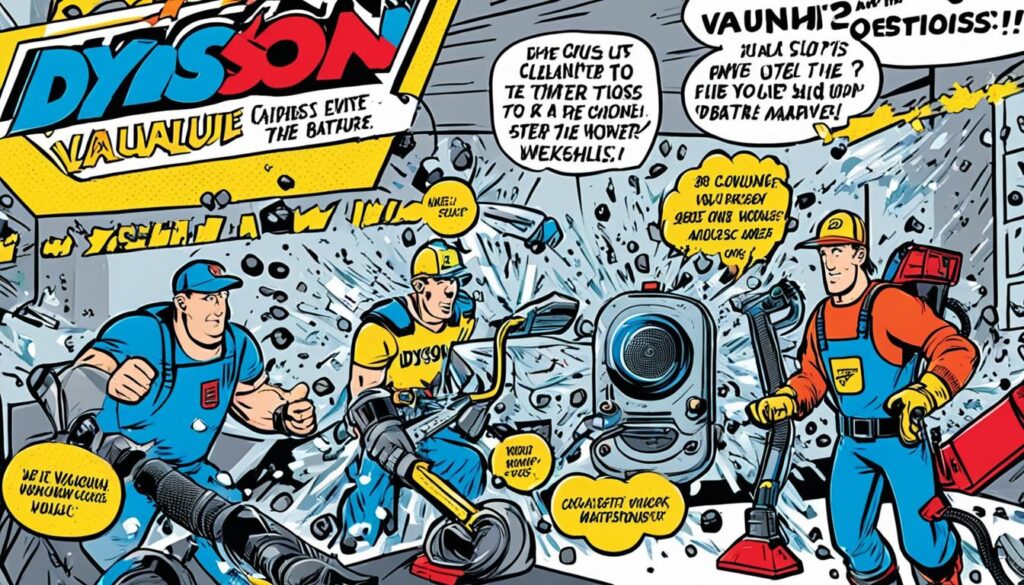
When it comes to cordless stick vacuums, the Shark Vertex Pro Lightweight Cordless Stick Vacuum is a top alternative21. With an impressive power of 309W and a noise level of approximately 80dBA, this vacuum delivers exceptional cleaning performance. It offers power and versatility, making it a great choice for those in search of a Dyson alternative.
For those who prefer upright vacuums, the Shark Stratos Upright Vacuum is a standout alternative21. With an impressive power of 1344W and a dust bin capacity of 1.48qt, it provides efficient cleaning and ample storage for dirt and debris. This powerful upright vacuum is a reliable option for those seeking an alternative to Dyson’s upright models.
When it comes to cordless convenience, the Shark Vertex Cordless Stick Vacuum offers an excellent alternative to Dyson21. With a power of 281W and up to 60 minutes of battery life, it provides reliable performance and longer cleaning sessions without the need for constant recharging. This cordless stick vacuum is an affordable option for those looking for the convenience of a cordless vacuum.
If you’re on a tight budget, the Levoit VortexIQ ONE stands out as a budget-friendly Dyson alternative21. This vacuum offers exceptional suction power at an affordable price point. It provides efficient cleaning performance without breaking the bank, making it an ideal choice for those seeking affordability without compromising on quality.
For those interested in smart features, the Tineco Pure ONE is a recommended Dyson alternative21. With its innovative dust-sensing technology and clever LED screen, this vacuum offers advanced functionality and ease of use. It combines smart features with reliable performance, making it an attractive alternative for tech-savvy users.
For pet owners dealing with stubborn pet hair, the Bissell ICONPet is an excellent alternative to Dyson21. It features anti-hair wrap technology, which prevents hair from getting tangled in the vacuum’s brush roll. This powerful vacuum effectively tackles pet hair, making it a reliable choice for pet owners in need of an alternative to Dyson’s pet-focused models.
If allergies are a concern, the Samsung Bespoke Jet offers a viable alternative to Dyson21. With its ergonomic design and efficient filtration system, it provides optimal air quality and reduces allergens in your home environment. This vacuum is a reliable option for those seeking an alternative with allergy-specific features.
When it comes to bagged vacuums, the SEBO Automatic offers a powerful alternative to Dyson21. With its industrial aesthetics and powerful performance, this vacuum delivers exceptional cleaning results. It is worth noting that this alternative comes at a higher price point, making it a desirable choice for those willing to invest in a top-of-the-line bagged vacuum.
For those in search of a robot vacuum alternative to Dyson, the iRobot Roomba j7+ stands out21. With its smart and efficient design, this robot vacuum offers a hands-free cleaning experience. It navigates seamlessly through your home, providing efficient cleaning and making it an excellent choice for those looking to embrace automation.
These alternatives to Dyson vacuums provide cost-effective, reliable, and efficient cleaning solutions. Whether you’re on a tight budget, prioritize specific features, or simply prefer a different brand, these vacuum options offer viable alternatives to Dyson’s lineup.
Conclusion
In conclusion, Dyson vacuums offer powerful suction and innovative features that make them a popular choice for cleaning carpets and hard floors. The statistical data22shows that Dyson vacuums have a typical lifespan of five to six years, which speaks to their durability and quality. While they may be priced higher than other vacuum brands, the22data also highlights that Dyson vacuums undergo stringent quality control and testing procedures to ensure functionality and longevity.
The23statistical data reveals the impressive performance of the Dyson V8 cordless vacuum. Despite its higher price of $469.99, the V8 offers 40 minutes of maximum run time on low power, powerful suction of 115 airwatts, and a whole machine HEPA filtration system. The V8’s detangling Motorbar cleaner head and updated floor head design further enhance its performance and convenience.
Looking ahead, Dyson has introduced newer cordless vacuum models like the V12, V15, and Gen5 series, as per the23data. The Dyson V12 Detect Slim, priced at $500, offers a longer battery run time of 60 minutes and weighs 5.2 pounds, making it more lightweight compared to the V8 and V15 models.
Considering this information, the decision of whether Dyson vacuums are worth it ultimately depends on individual needs and preferences. While they may come with a higher price tag, the reliable performance, innovative features, and long-lasting build quality make them a valuable investment in keeping your home clean.
